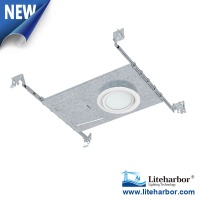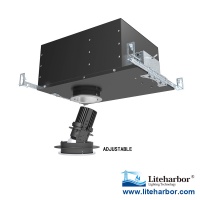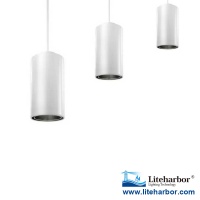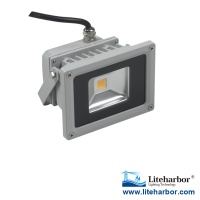Light Bulb Type
Light Bulb Type
Base on the Bulb Shape
Light Bulb usually can be divided into A SERIES, B SERIES, C-7/F SERIES, G SERIES, P-25 P-35 SERIES, BR SERIES, R SERIES, RP-11/S SERIES, PAR SERIES and T SERIES.
|
A
|
Arbitrary (Standard)
|
|
PS
|
Pear Shape
|
|
B/BA
|
Bulged, Bulged with angular tip
|
|
C/CA
|
Conical, Candel shape with bent tip
|
|
RP
|
Reflector, Pear shape
|
|
S
|
Straight-sided shape (compare with CA and BA)
|
|
ST
|
Spherical Tubular
|
|
F
|
Flame
|
|
R
|
Reflector
|
|
MR
|
Multi-Faceted Reflector
|
|
BR
|
Bulbous Reflector
|
|
G
|
Globe
|
|
T
|
Tubular
|
|
BT
|
Bulged Tubular
|
|
E/ED
|
Elliptical, Elliptical with dimple in the crown
|
|
AR
|
Aluminized Reflector
|
|
PAR
|
Parabolic Aluminized Reflector
|







Lamp Sizes References
All lamps have a specific "bulb type" designation that describes the shape of the lamp and the size of the lamp (diameter). The designation is a two part code consisting of a letter and a number. The letter indicates the shape of the lamp and the number relates to the diameter of the lamp in eighths of an inch.
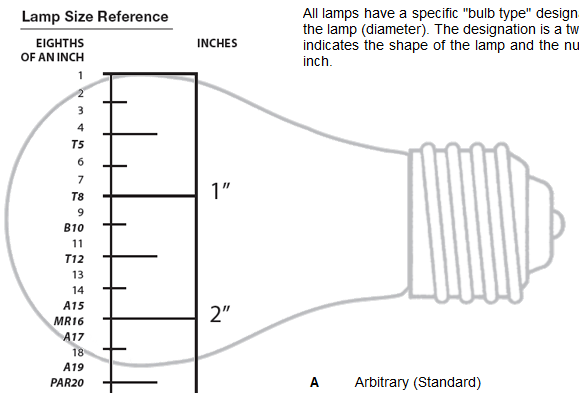
Bulb Bases and Sockets Explained
Naming Conventions of Light Bulb Sockets and Base Types
Light bulb bases and sockets are normally defined by a letter-number-letter format, with the last letter optional. The first letter designates the shape or form of the base, the numbers represent either the width of the base or the distance between the pins. The second letter designates the number of pins or contacts on the lamp. The numbers are normally in millimeters. LED light bulb sockets and bases are manufactured to the same standards as halogen, incandescent and other traditional lights.
By way of example a standard USA screw-in incandescent bulb has a base type of E26. E stands for Edison screw-in and the 26 means that the base is 26 millimeters. E27 is the European standard screw-in size. (note: Gallan part numbers that contain 'E27' sold in North America will fit E26 sockets and in many cases support voltages from 85VAC to 220VAC)
LED light bulbs and LED lamps use the same socket designations as traditional light bulbs. Retrofit Solid State Lights (SSL) that use LEDs or OLEDs are normally designed to be compatible with existing sockets.
Light Bulb Base and Socket Shape Types
B Bayonet Collar Base
E Edison Screw Light Base
F Single Pin Type Base
G Multiple Pin Type Light Bulb Base
K Cable Connections
P Pre-focused Light Base
R Recessed Contact(s) Base
S Shell-type Light Bulb Base
T Telephone Slide Base
W Wedge Base
X Special Type Lightbulb Base
Lamp Number of Pin or Contacts
s Single Pin
d Double or Bi-Pin Base Type
t Triple Pin Base or Tri-Pin Base or 3 Pin Base
q Quadruple Pin Base or 4 Pin Base.
Bulb Type Details
B or Bayonet light bulb base and sockets
LED light bulb bayonet base types.
Examples of these base types include: BA75, BA95, BA150, BAY150, BA155, BA220
Bi-pin and G sockets and bases
LED light bulb bi-pin base types.
Examples of LED bipin base types include: G4, G5, GU5.3, GU10, G13, T-1/2, T-3/4, T-1, T-1 1/4, T-1 3/4.
E or Edison screw-in sockets and bases
Screw-in bases, also known as Edison bases and light bulb sockets are used through out the world.
The naming conventions include terms like medium base and candelabra base. Often they are referred to with a letter-number designation that starts with an "E" followed by the number of millimeters in diameter of the base. If your base ends in a "d" this indicates a double contact base, this is typically used for 3-way bulbs.
"E" or Edison base types, sizes and names
|
Base Number
|
Diameter
|
Base or Socket Name
|
|
E5
|
5mm
|
Lilliput Edison Screw Base
|
|
E10
|
10mm
|
Miniature Edison Screw Base
|
|
E11
|
11mm
|
Mini-Candelabra Edison Screw Base
|
|
E12
|
12mm
|
Candelabra Edison Screw Base
|
|
E14
|
14mm
|
Small Edison Screw Base (supports 240V)
|
|
E17
|
17mm
|
Intermediate Edison Screw Base
|
|
E26
|
26mm
|
Medium Edison Screw Base
|
|
E27
|
27mm
|
Medium Edison Screw Base (supports 240VAC)
|
|
E39
|
39mm
|
Mogul or Giant Edison Screw Base
|
|
E40
|
40mm
|
Mogul or Giant Edison Screw Base (supports 240VAC)
|
F or Flange light bulb base and sockets
LED light bulb flange base types.
LED flanged bases include base types like: micro-midget flanged base, midget flanged, miniature midget flanged, sub-midget flanged, and special-midget flanged base types. These LED light bulb types are used in automotive and electronic device lighting applications.
G or Bi-pin light bulb base and sockets
The "G" base type of lamp and light bulb is used to designate a "pinned" base. This can include several pin types and different numbers of pins.
Designation is by letter(s)-numbers-optional letter: The first letters include "G" followed by an optional U, X, Y or Z. Next is a number that designates the number of millimeters between the center of each pin. Finally the optional final letter designates the number of pins, no letter implies 2 pins as does a d for double. Pin number designations include: s : Single, d : Double, t : Triple for 3 pins and q : Quadruple for 4 pins.
Examples include: GU10 base type, G24q base type, or for T8 tubes G13 bi-pin.
|
Type
|
Pin to pin distance
|
Pin Diameter
|
Typical Bulbs that use this base
|
|
G4
|
4mm
|
0.65-0.75mm
|
MR11 and other small halogens of 5/10/20 watt and 6/12 volt
|
|
GU4
|
4mm
|
0.95-1.05mm
|
|
|
GY4
|
4mm
|
0.65-0.75mm
|
|
|
GZ4
|
4mm
|
0.95-1.05mm
|
|
|
G5
|
5mm
|
|
T4 and T5 fluorescent tubes
|
|
G5.3 GU5.3 GX5.3 GY5.3
|
5.33 mm
|
1.47-1.65mm
|
MR16 and other small bulbs typically using 12/24 volts
|
|
G6.35 GX6.35 GY6.35
|
6.35 mm
|
0.95-1.3mm
|
|
|
G8
|
8mm
|
|
|
|
G9
|
9mm
|
|
|
|
GU10
|
10mm
|
|
bulbs using twist-lock bi-pin base
|
|
G13
|
12.7mm
|
|
T8,T10 & T12 fluorescent tubes
|
|
G23
|
23mm
|
2mm
|
|
|
GU24
|
24mm
|
|
2 and 4 pin bases with center key
|
|
GX53
|
53mm
|
|
used with puck shaped lamps typically twist-lock
|
K or Cable connected lights and lamps
the designation of K to indicate that a cable is the power connection for a lamp. So where you see a K used in a base type location in a part number. You can assume that the product is a wired connection to power.
P or Pre-focused lamp base and sockets
LED light bulb pre-focus base types: S.C. Prefocus and D.C. Prefocus
R or Recessed lamp base and sockets
S or Slide light bulb base and sockets
LED light bulb slide base types.
Examples of LED slide base types like Slide #1.
W or Wedge light bulb base and sockets
LED light bulb wedge base types.
Examples of LED Wedge base types include: D.F Wedge and S.F. Wedge sockets.



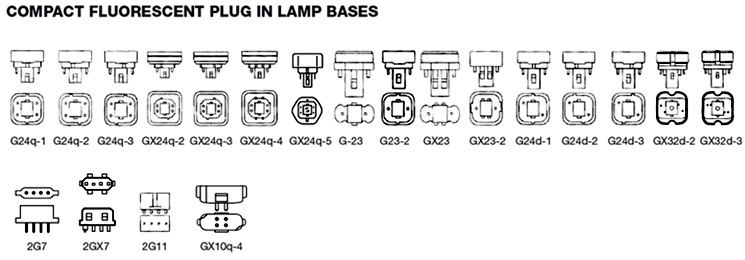


Characteristics of Light
A Guide to Lamp Brightness: Lumen Scale
In the past, consumers have used wattage to rate the brightness of a lamp. However, wattage is not an accurate indicator of lamp brightness. Energy efficient light sources such as Compact Fluorescent Lamps (CFL) have much lower wattages while still producing a great amount of light. Wattage is simply a measure of the amount of energy consumed. Light output, on the other hand, is a measure of luminous flux or simply put, the brightness of the lamp. It is measured in LUMENS.
As more consumers become aware of this common misconception, lumens will become one of the most important factors in lamp selection.
So, if you're still asking WATT lamp you need, you're asking the wrong question.
Just remember, more lumens = more light.
The guide at right shows typical LUMEN ratings for incandescent lamps.
Color Rendering Index
CRI, or Color Rendering Index (Ra), measures how well a given light source will render color. Scientists evaluate this by using 8 reference colors and comparing how they look under the light source to how those same colors appear under two reference sources: incandescent light (for warm color lamps) and daylight (for cool color lamps). CRI is represented by a number on a scale from 0 to 100 with 0 being "poor" and 100 being "excellent". The lower the number, the more distorted a color will look under the light source. As you can see in these two pictures, a light source has the ability to enhance or distort the colors of an object.
Correlated Color Temperature: Warm or Cool
Color appearance, also known as Correlated Color Temperature (CCT), is a measure of how warm or cool a light source appears to the human eye. It is measured in degrees Kelvin.
The majority of light sources have a Kelvin temperature within the range of 2700K to 6500K. As a point of reference, daylight at noon has a Kelvin temperature of 5000K. Incandescent light sources typically range from 2700-3500K. Compact Fluorescents and LEDs can range from 2700-6500K. The higher the Kelvin temperature, the cooler the light source appears and the lower the Kelvin temperature, the warmer the light source appears.
|
Color Temperature
|
Warm White
|
Soft White
|
Neutral
|
Cool
|
Soft Daylight
|
Daylight
|
|
Kelvin
|
2700K
|
3000K
|
3500K
|
4100K
|
5000K
|
6500K
|
|
Mood & Effects
|
Friendly, personal, intimate
|
Soft, warm, pleasing light
|
Friendly, Inviting, Non-threatening
|
Neat, clean, efficient
|
Bright, alert
|
Bright, cool
|
|
Applications
|
Homes, Libraries, restaurants
|
Homes, hotel rooms, lobbies, restaurants, retail stores
|
Executive Offices, Public reception areas, supermarkets
|
Office, classrooms, mass merchandisers, showrooms
|
Graphics industry, hospitals
|
Jewelry stores, beauty salons, galleries, museums, printing
|
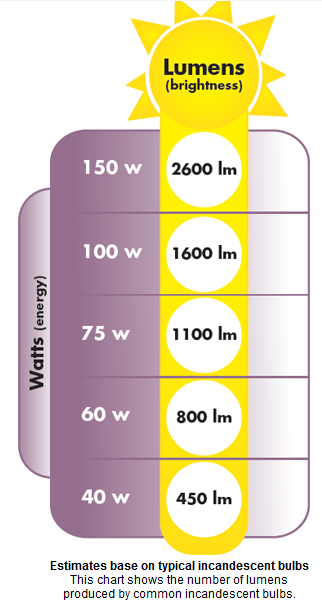

 RESOURCE
RESOURCE















